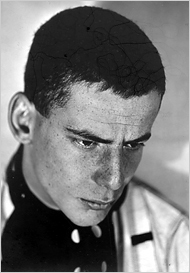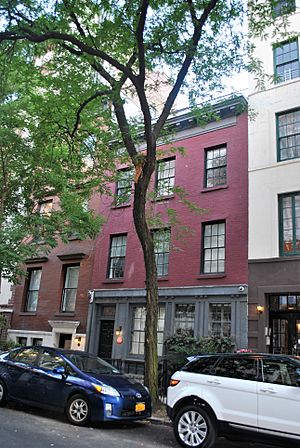Lincoln Kirstein facts for kids
Quick facts for kids
Lincoln Kirstein
|
|
|---|---|

Lincoln Kirstein by Walker Evans
|
|
| Personal details | |
| Born | May 4, 1907 Rochester, New York, U.S. |
| Died | January 5, 1996 (aged 88) Manhattan, New York, U.S. |
| Spouse |
Fidelma Cadmus
(m. 1941; died 1991) |
| Parents | Louis E. Kirstein Rose Stein |
| Education | Berkshire School |
| Alma mater | Harvard University |
| Occupation | Writer, philanthropist |
| Known for | Co-founder of the New York City Ballet |
| Awards |
|
| Military service | |
| Allegiance | |
| Years of service | 1943–1945 |
| Rank | Private First Class |
| Unit | MFAA |
| Battles/wars | World War II |
Lincoln Edward Kirstein (May 4, 1907 – January 5, 1996) was an American writer, a person who organizes and presents public shows (an impresario), an expert in art (an art connoisseur), and someone who gives money to good causes (a philanthropist). He was an important cultural figure in New York City. He is especially known for helping to start the New York City Ballet. He worked hard to build and support the ballet company for over 40 years. He was the company's general director from 1946 to 1989. The New York Times newspaper called him "an expert in many fields." He also organized art shows and lecture tours.
Contents
Early Life and Education
Lincoln Kirstein was born in Rochester, New York. His parents were Rose Stein and Louis E. Kirstein. His family was wealthy. His grandfather, Edward Kirstein, owned a successful clothing company.
Lincoln went to a private school called Berkshire School. He graduated in 1926. Then, he went to Harvard University, where his father had also studied. He graduated from Harvard in 1930. His father was a vice-president at Filene's Department Store.
A Career in the Arts
Starting a Magazine
When Lincoln was in college at Harvard, he wanted to join the student literary magazine. But they didn't invite him, even though he had written good articles. So, in 1927, he and his friend Varian Fry decided to start their own magazine. His father helped pay for it. They called it Hound & Horn.
After college, in 1930, Lincoln moved to New York City and took the magazine with him. Hound & Horn became very well-known in the art world. It was published until 1934. At that point, Lincoln decided to focus his time and money on the ballet dancer and choreographer George Balanchine. He also wanted to help create the School of American Ballet.
Bringing Ballet to America
Lincoln became very interested in ballet after seeing Balanchine's Apollo performed by a group called the Ballets Russes. He was determined to bring Balanchine to the United States.
In October 1933, Lincoln, along with Edward M.M. Warburg and Vladimir Dimitriew, started the School of American Ballet. It began in Hartford, Connecticut. In 1934, the school moved to New York City. Students from the school performed a ballet called Serenade at a private party. This was the first major ballet that Balanchine created in the United States.
A few months later, Lincoln, Warburg, Balanchine, and Dimitriew founded the American Ballet. This company later became the main ballet group at the Metropolitan Opera. However, Lincoln felt this arrangement wasn't good because the opera company didn't give the ballet enough money or artistic freedom.
Serving in World War II
Lincoln's work in theater was paused when the United States joined World War II. He joined the army in 1943. Before going overseas, he started a project to collect and document art made by soldiers. This project later became an exhibit and a book called Artists Under Fire.
In 1944, Lincoln went to London to work for the U.S. Arts and Monuments Commission. He was then moved to a special unit in France. This unit became known as the Monuments, Fine Arts, and Archives (MFAA) program. Their job was to rescue and protect European art during the war.
In January 1945, Lincoln was promoted to private first class. His unit moved into Germany. He helped find artworks around Munich and from the salt mines at Altaussee. He wrote an article about this experience called "The Quest for the Golden Lamb." It was published in September 1945, the same month he left the army.
Building the New York City Ballet
In 1946, Balanchine and Kirstein founded the Ballet Society. In 1948, it was renamed the New York City Ballet. Lincoln wrote in a letter that year, "The only justification I have is to enable Balanchine to do exactly what he wants to do in the way he wants to do it." Lincoln was the company's general director from 1946 until 1989.
In 1959, Lincoln wrote a book called What Ballet Is All About. He explained that Western ballet is "a clear if complex blending of human anatomy, solid geometry and acrobatics offered as a symbolic demonstration of manners—the morality of consideration for one human being moving in time with another."
The poet Vernon Scannell once said that Lincoln saw dancers as athletes, not just artists. He believed their skills were mostly physical. Lincoln and Balanchine worked together closely until Balanchine passed away in 1983.
Writing and Books
Lincoln Kirstein wrote a lot during his life, over 60 years. He published almost 600 works. He wrote books about the artists he supported. He also wrote about many other things that interested him. These included Hollywood stars, cats in fairy tales, tap dancers, and Buddhist temples. Lincoln felt that his writing, which started with Hound & Horn, helped him have many exciting adventures.
Personal Life
Lincoln Kirstein kept a diary from 1919 until the late 1930s. A writer named Martin Duberman used these diaries and Lincoln's many letters to learn about his personal life for a biography published in 2007.
In 1941, Lincoln married Fidelma Cadmus. She was a painter and the sister of artist Paul Cadmus. Lincoln and Fidelma had a good relationship, though sometimes it was difficult. She passed away in 1991.
Lincoln had many different interests, a lot of ambition, and a strong interest in high culture. Because he had his own money, he was able to make friends with many creative people from different art fields. These friends included writers, artists, photographers, and filmmakers.
In his later years, Lincoln faced challenges with his mental health. He also had two heart attacks in 1975. Despite these health issues, his professional creativity usually remained strong until the end of his life.
Legacy and Impact
The English critic Clement Crisp said that Lincoln was "one of those rare talents who touch the entire artistic life of their time." He was involved in ballet, film, literature, theater, painting, sculpture, and photography.
Lincoln helped organize a tour in 1959 for musicians and dancers from the Japanese Imperial Household Agency. This was special because Japanese Imperial court music, called gagaku, was rarely performed outside of Japan at that time.
Lincoln also helped fund and commission the building for the New York City Ballet. This building is the New York State Theater at Lincoln Center. It was designed in 1964 by architects Philip Johnson and John Burgee. The theater's inside, with its glittery red and gold, reminds people of the beautiful stage designs of the Ballets Russes. He was the general director of the ballet company from 1948 to 1989.
Lincoln was also one of the public figures who worked to save Olana. This was the home of artist Frederic Edwin Church. It later became a National Historic Landmark in 1965 and a New York State Historic Site.
On March 26, 1984, President Ronald Reagan gave Lincoln Kirstein the Presidential Medal of Freedom. This award recognized his important contributions to the arts.
Lincoln was also a serious collector of art and historical items. After the New York Public Library for the Performing Arts opened at Lincoln Center, he gave many historical dance materials to the Jerome Robbins Dance Division. Before he passed away in 1996, Lincoln also donated his personal papers, artworks, and other materials related to dance history and his life in the arts to the division. Lincoln was also a major supporter of the artist Paul Cadmus, who was his wife Fidelma's brother. He bought many of Paul's paintings and helped him with his living expenses.
Honors and Awards
- Presidential Medal of Freedom, U.S.
- Handel Medallion, NYC, U.S.
- Brandeis University Notable Achievement Award, U.S.
- National Medal of Arts, U.S., 1985.
- Royal Society of Arts, Benjamin Franklin Medal, UK, 1981.
- National Society of Arts and Letters, National Gold Medal of Merit Award, U.S.
- National Museum of Dance Mr. & Mrs. Cornelius Vanderbilt Whitney Hall of Fame inductee, 1987.
Theatrical Works
Lincoln Kirstein was involved in several theater and ballet productions:
- The Saint of Bleecker Street (1954-1955) – He was the Production Supervisor for this play with music.
- Misalliance (1953) – He was the Managing Director for this comedy revival.
- Billy the Kid (1938) – He wrote the story (libretto) for this ballet.
- Filling Station (1938) – He also wrote the story (libretto) for this one-act ballet.
Published Works
Lincoln Kirstein wrote many books and articles. Here are some of them:
- 1932 – Flesh Is Heir: An Historical Romance, a novel
- 1935 – Dance: A Short History of Classic Theatrical Dancing
- 1938 – Photographs of America: Walker Evans
- 1939 – Ballet Alphabet: A Primer for Laymen
- 1943 – American Battle Painting: 1776–1918
- 1952 – The Classic Ballet: Basic Technique and Terminology with Muriel Stuart
- 1959 – What Ballet Is All About: An American Glossary, with photographs by Martha Swope
- 1965 – Rhymes and More Rhymes of a Pfc., a book of poems. The poet W.H. Auden praised this book as "the most convincing, moving and impressive" book he had read about World War II.
- 1973 – The New York City Ballet with photographs by Martha Swope and George Platt Lynes
- 1975 – Nijinsky Dancing
- 1984 – Paul Cadmus
- 1987 – Quarry: A Collection in Lieu of Memoirs
- 1987 – The Poems of Lincoln Kirsten
- 1991 – By with to and from: A Lincoln Kirstein Reader
- 1994 – Mosaic: Memoirs
See also
- Monuments, Fine Arts, and Archives program
- Monuments Men Foundation for the Preservation of Art
- The Monuments Men – In this film, the character of Pvt. Preston Savitz, played by Bob Balaban, is partly based on Kirstein.


